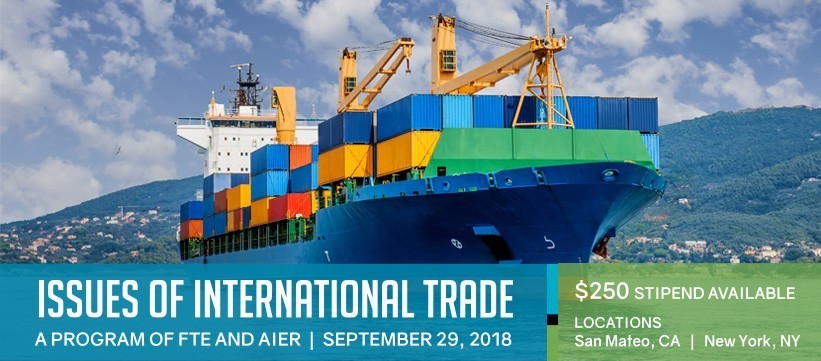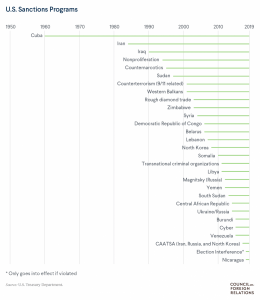

In spite of general recognition that trade creates wealth, the history of international trade is largely a series of attempts by different nations to gain some elusive advantage in the trading game by erecting trade barriers. In contrast to the general historical trend, the last two decades of the twentieth century were characterized by a growing number of trade agreements and the lowering of trade barriers. The result is that at the turn of the 21 st century, it was possible to assert that international exchange was freer than at any other time in history. Lesson 2 reviews the vocabulary of trade restriction before analyzing the impact of trade-inhibiting policies and moving on to the more important question of why the urge to erect barriers seems so resistant to the economic logic that restricting trade restricts the creation of wealth.
| Trade barrier | Tariff | Subsidy |
| Trade agreement | Quota | Protectionism |
| Embargo | Sanction | Public Choice Theory |
Standard 5: Students will understand that: Voluntary exchange occurs only when all participating parties expect to gain. This is true for trade among individuals or organizations within a nation, and among individuals or organizations in different nations.
Students will be able to use this knowledge to: Negotiate exchanges and identify the gains to themselves and others. Compare the benefits and costs of policies that alter trade barriers between nations, such as tariffs and quotas.
Benchmarks, Grade 8: At the completion of grade 8, students will know
Benchmarks, Grade 12: At the completion of grade 12, students will know
Standard 6: Students will understand that: When individuals, regions, and nations specialize in what they can produce at the lowest cost and then trade with others, both production and consumption increase.
Students will be able to use this knowledge to: Explain how they can benefit themselves and others by developing special skills and strengths.
Benchmarks, Grade 8: At the completion of grade 8, students will know
Benchmarks, Grade 12: At the completion of grade 12, students will know
Standard 17: Students will understand that: Costs of government policies sometimes exceed benefits. This may occur because of incentives facing voters, government officials, and government employees, because of actions by special interest groups that can impose costs on the general public, or because social goals other than economic efficiency are being pursued.
Students will be able to use this knowledge to: Identify some public policies that may cost more than the benefits they generate, and assess who enjoys the benefits and who bears the costs. Explain why the policies exist.
Benchmarks, Grade 12: At the completion of grade 12, students will know
Trade Restrictions – Erecting Barriers to Trade
Bureau of Labor Statistics data. Compiled for the FTE by Dr. Jamie Wagner Economics Professor and Director, UNO Center for Economic Education, University of Nebraska at Omaha

The United States-Mexico-Canada Agreement (USMCA) was signed replacing NAFTA in November 2018. Once ratified by the 3 countries, it will replace NAFTA. The agreement was spun as a way to deliver American workers from NAFTA which had been taking jobs and money from the US and moving it towards Mexico. The creation of NAFTA in 1994 was an attempt to spread to Mexico the benefits that had been realized by the elimination of tariffs between the U.S. and Canada.
It is difficult to quantify exactly how much wealth has been created by international trade. Because trade encourages specialization, which in turn causes increases in productivity, some of what are referred to as gains from trade are actually gains from increased productivity. Since both trade and productivity contribute to wealth, it isn’t always clear which caused what portion of the increase. It must also be acknowledged that although international trade is freer than at any time in our history, significant barriers remain. The world is still entangled in tariffs and quotas, and currently confronts economic, environmental, cultural, and human rights issues in trying to create more bridges to the wealth that trade creates. The caveats acknowledged, it is important to emphasize that the relationship between the trend toward freer trade and the growing wealth of participating nations is both real and significant.